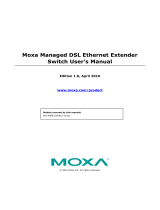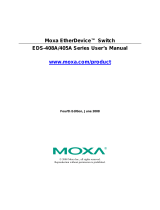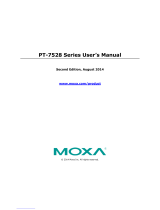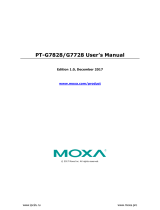Page is loading ...

Moxa Managed Switch Next-generation
OS (v4.x) Layer 2 User Manual
Version 1.0, June 2023
www.moxa.com/products
© 2023 Moxa Inc. All rights reserved.
Models covered by this user's manual:
MDS-G4000 Series Managed Ethernet Switches
MDS-G4000-L3 Series Managed Ethernet Switches
MDS-G4000-4XGS Series Managed Ethernet Switches
MDS-G4000-L3-4XGS Series Managed Ethernet Switches
RKS-G4000 Series Managed Ethernet Switches

Moxa’s Managed Switch Next-generation OS (v4.x) Layer 2 User
Manual
The software described in this manual is furnished under a license agreement and may be used only in accordance
with the terms of that agreement.
Copyright Notice
© 2023 Moxa Inc. All rights reserved.
Trademarks
The MOXA logo is a registered trademark of Moxa Inc.
All other trademarks or registered marks in this manual belong to their respective manufacturers.
Disclaimer
• Information in this document is subject to change without notice and does not represent a commitment
on the part of Moxa.
• Moxa provides this document as is, without warranty of any kind, either expressed or implied, including,
but not limited to, its particular purpose. Moxa reserves the right to make improvements and/or
changes to this manual, or to the products and/or the programs described in this manual, at any time.
• Information provided in this manual is intended to be accurate and reliable. However, Moxa assumes no
responsibility for its use, or for any infringements on the rights of third parties that may result from its
use.
• This product might include unintentional technical or typographical errors. Changes are periodically
made to the information herein to correct such errors, and these changes are incorporated into new
editions of the publication.
Technical Support Contact Information
www.moxa.com/support

Table of Contents
1. About This Manual ................................................................................................................................ 5
Symbols for the Meanings in the Web Interface Configurations .................................................................... 6
About Note, Attention, and Warning ......................................................................................................... 7
Configuration Reminders ........................................................................................................................ 8
A: About Mandatory Parameters ....................................................................................................... 8
B: Configurations before Enable/Disable ............................................................................................ 8
2. Getting Started ..................................................................................................................................... 9
Log in by Web Interface.......................................................................................................................... 9
Connecting to the Switch ............................................................................................................... 10
Log in by RS-232 Console ..................................................................................................................... 11
Log in by Telnet ................................................................................................................................... 13
3. Web Interface Configuration .............................................................................................................. 16
Function Introduction ........................................................................................................................... 16
Device Summary ................................................................................................................................. 17
Model Information ........................................................................................................................ 17
Panel Status ................................................................................................................................ 18
Event Summary (Last 3 Days) ....................................................................................................... 19
CPU Utilization History .................................................................................................................. 20
System ............................................................................................................................................... 21
System Management .................................................................................................................... 21
Account Management .................................................................................................................... 33
Network ...................................................................................................................................... 40
Time ........................................................................................................................................... 53
Port ................................................................................................................................................... 62
Port Interface .............................................................................................................................. 62
Link Aggregation .......................................................................................................................... 66
PoE............................................................................................................................................. 70
Layer 2 Switching ................................................................................................................................ 77
VLAN .......................................................................................................................................... 78
GARP Overview ............................................................................................................................ 86
MAC ........................................................................................................................................... 87
QoS ............................................................................................................................................ 89
Multicast ................................................................................................................................... 104
Network Redundancy ......................................................................................................................... 110
Layer 2 Redundancy ................................................................................................................... 111
Management ..................................................................................................................................... 137
Network Management ................................................................................................................. 137
Security ............................................................................................................................................ 141
Device Security .......................................................................................................................... 141
Management Interface ................................................................................................................ 141
Network Security ............................................................................................................................... 149
IEEE 802.1X .............................................................................................................................. 149
Network Loop Protection ............................................................................................................. 173
Authentication ........................................................................................................................... 181
Login Authentication ................................................................................................................... 182
Diagnostics ....................................................................................................................................... 187
System Status ........................................................................................................................... 187
Log & Event Notification .............................................................................................................. 197
Diagnosis .................................................................................................................................. 213
Industrial Applications ........................................................................................................................ 227
IEC 61850 ................................................................................................................................. 228
MMS Settings ............................................................................................................................. 228
Modbus TCP ............................................................................................................................... 233
EtherNet/IP ............................................................................................................................... 234
Maintenance and Tools ....................................................................................................................... 235
Standard/Advanced Mode ............................................................................................................ 236
Disable Auto Save ...................................................................................................................... 236
Reboot ...................................................................................................................................... 239

Reset to Default ......................................................................................................................... 240
Log Out of the Switch ................................................................................................................. 241
A. Account Privileges List...................................................................................................................... 242
Account Privileges List ........................................................................................................................ 242
B. Event Log Description ....................................................................................................................... 244
Event Log Description......................................................................................................................... 244
C. SNMP MIB File .................................................................................................................................. 248
Standard MIB Installation Order .......................................................................................................... 248
MIB Tree .......................................................................................................................................... 248
D. MODBUS Data Map and Information ................................................................................................. 250
Interpretation of Moxa Switches .......................................................................................................... 250
Product Code Table ............................................................................................................................ 258
E. CIP Objects of EtherNet/IP .............................................................................................................. 260
Identity Object .................................................................................................................................. 260
Message Router Object ....................................................................................................................... 262
Assembly Object ................................................................................................................................ 263
Connection Manager Object ................................................................................................................ 264
Base Switch Object ............................................................................................................................ 265
Port Object ....................................................................................................................................... 266
TCP/IP Interface Object ...................................................................................................................... 267
Ethernet Link Object .......................................................................................................................... 268
Moxa Networking Object (Vendor Specific) ............................................................................................ 273
Electronic Data Sheet (EDS) File .......................................................................................................... 279
Rockwell RSLogix 5000 Add-On Instructions (AOI) ................................................................................. 279
AOI Installation .......................................................................................................................... 279
CIP Tags ................................................................................................................................... 293
Monitoring AOI Tags ................................................................................................................... 298
F. Security Guidelines ........................................................................................................................... 303
Installation ....................................................................................................................................... 303
Physical Installation .................................................................................................................... 303
Account Management .................................................................................................................. 303
Vulnerable Network Ports ............................................................................................................ 304
Operation ......................................................................................................................................... 304
Maintenance ..................................................................................................................................... 306
Decommission ................................................................................................................................... 306

Moxa’s Managed Switch Next-generation OS (v4.x) Layer 2 User Manual
5
1. About This Manual
Thank you for purchasing Moxa’s managed switch. Read this user’s manual to learn how to connect your
Moxa switch with various interfaces and how to configure all settings and parameters via the user-friendly
web interface.
Three methods can be used to connect to the Moxa’s switch, which all will be described in the next two
chapters. See the following descriptions for each chapter’s main functions.
Chapter 2: Getting Started
In this chapter, we explain the instruction on how to initialize the configuration on Moxa’s switch. We
provide three interfaces to access the configuration settings: RS-232 console interface, telnet interface, and
web interface.
Chapter 3: Web Interface Configuration
In this chapter, we explain how to access a Moxa switch’s various configuration, monitoring, and
management functions. The functions can be accessed by web browser. We describe how to configure the
switch functions via web interface, which provides the most user-friendly way to configure a Moxa switch.
Appendix A: Account Privileges List
This appendix describes the read/write access privileges for different accounts on Moxa’s Managed Ethernet
Series switch.
Appendix B: Event Log Description
In this appendix, users can check the event log name and its event log description. When any event occurs,
this appendix helps users quickly check the detailed definition for each event.
Appendix C: SNMP MIB File
This appendix contains the SNMP MIB files so that users can manage the entities in a network with Moxa’s
switch.

Moxa’s Managed Switch Next-generation OS (v4.x) Layer 2 User Manual
6
Symbols for the Meanings in the Web Interface
Configurations
The Web Interface Configuration includes various symbols. For your convenience, refer to the following table
for the meanings of the symbols.
Symbols
Meanings
Add
Read detailed information
Clear all
Column selection
Refresh
Enable/Disable Auto Save
When Auto Save is disabled, users need to click this icon to save the configurations.
Export*
Edit
Re-authentication
Delete
Panel View
Expand
Collapse
Hint Information
Settings
Data Comparison
Menu icon
Change mode
Locator
Reboot
Reset to default
Logout
Increase
Decrease
Equal
Menu
Search

Moxa’s Managed Switch Next-generation OS (v4.x) Layer 2 User Manual
7
*The Export function helps users save the current configurations or information for the specific functions. It
is located on the upper part of the configuration area. There are two formats available: CVS, or PDF. Select
the format and save in your local computer.
About Note, Attention, and Warning
Throughout the whole manual, users will see some notes, attentions, and warnings. Here are the
explanations for each definition.
Note: It indicates the additional explanations for the situation that users might encounter. Here is the
example:
NOTE
By default, the password assigned to the Moxa switch is moxa. Be sure to change the default password
after you first log in to help keep your system secure.
Attention: It indicates the situations where users might take some extra care or it might bring some
problems. Here is the example:
ATTENTION
When a different type of module has been inserted into the switch, we suggest you configure the settings,
or use reset-to-default.
Warning: It indicates the situations where users need to pay particular attention to, or it might bring
serious damage to the system or the switch. Here is an example:
WARNING
There is a risk of explosion if the battery is replaced by an incorrect type.

Moxa’s Managed Switch Next-generation OS (v4.x) Layer 2 User Manual
8
Configuration Reminders
In this section, several examples will be used to remind users when configuring the settings for Moxa’s
switch.
A: About Mandatory Parameters
1. The items with asterisks mean they are mandatory parameters that must be provided. In the figure
above, the parameters for VLAN, Version, and Query Interval all need to be provided, or it will not be
created or applied.
2. If the item is marked with red it means this item has been skipped. You need to fill in the parameters or
you cannot apply or create the function.
In addition, some parameter values will be limited to a specific range. If the values exceed the range, it
cannot be applied or created.
B: Configurations before Enable/Disable
In another situation, some settings can be configured first, but remain disabled. Users can decide to enable
them when necessary without configuring the same settings again. This is particularly convenient and user-
friendly when configuring various settings. For example, in Spanning Tree configuration page, users can
configure the Guard settings first, but later select to disable the Guard settings in the General tab. When
users decide to enable the Guard settings, they only need to select Enable in General settings, so that the
Guard setting can be enabled at the same time.

Moxa’s Managed Switch Next-generation OS (v4.x) Layer 2 User Manual
9
2. Getting Started
In this chapter, we explain how to log in a Moxa’s switch for the first time. There are three ways to access
the Moxa switch’s configuration settings: RS-232 console, or web-based interface.
Log in by Web Interface
You can directly connect a Moxa switch to your computer with a standard network cable or install your
computer on the same intranet as your switch. You will then need to configure your computer’s network
settings. The default IP address for a Moxa switch is:
192.168.127.253
For example, you can configure the computer’s IP setting as 192.168.127.99, and the subnet mask as
255.255.255.0.
Click OK when finished.

Moxa’s Managed Switch Next-generation OS (v4.x) Layer 2 User Manual
10
Connecting to the Switch
Open a browser, such as Google Chrome, Internet Explorer 11, or Firefox, and connect to the following IP
address:
https://192.168.127.253
NOTE
To enhance network security, all HTTP connections will be automatically redirected to HTTPS connections.
In addition, when a web browser displays a warning message because a certificate has not been signed by
a certification authority, you may add an exception rule for that certificate in the web browser or use a
custom certificate to continue. Please go to the following: Security > Device Security > SSH & SSL > SSL
The default username and password are:
Username: admin
Password: moxa
Click LOG IN to continue. If you have logged in before, you will see a screen indicating the previous login
information. Click CLOSE.
Another system message will appear, reminding you to change the default password. We recommend that
you change your password, or a message will appear whenever you log in telling you to change your
password. You can change the password in the Account Management section. Click CLOSE to continue.

Moxa’s Managed Switch Next-generation OS (v4.x) Layer 2 User Manual
11
Log in by RS-232 Console
The Moxa’s managed switch offers a serial console port, allowing users to connect to the switch and
configure the settings. Do the following steps for the serial connection and configuration.
1. Prepare an RS-232 serial cable with an RJ45 interface.
2. Connect the RJ45 interface end to the console port on the switch, and the other end to the computer.
3. We recommend you use PComm Terminal Emulator for serial communication. The software can be
downloaded free of charge from Moxa’s website.
After installing PComm Terminal Emulator, access the Moxa switch’s console as follows:
4. From the Windows desktop, click Start Moxa PComm Terminal Emulator.
5. Select Open under the Port Manager menu to open a new connection.

Moxa’s Managed Switch Next-generation OS (v4.x) Layer 2 User Manual
12
6. The Property window should open. On the Communication Parameter tab for Ports, select the COM
port that is being used for the console connection. Set the other fields as follows: 115200 for Baud
Rate, 8 for Data Bits, None for Parity, and 1 for Stop Bits.
7. On the Terminal tab, select VT100 for Terminal Type, and then click OK to continue.

Moxa’s Managed Switch Next-generation OS (v4.x) Layer 2 User Manual
13
8. The console will prompt you to log in. The default login name is admin, and the default password is
moxa. This password will be required to access any of the consoles (web, serial, Telnet).
9. After successfully connecting to the switch by serial console, you can start configuring the switch’s
parameters by using command line instructions. Refer to the Moxa Command Line Interface Manual
for details.
NOTE
By default, the password assigned to the Moxa switch is moxa. Be sure to change the default password
after you first log in to help keep your system secure.
Log in by Telnet
Opening the Moxa switch’s Telnet or web console over a network requires that the PC host and Moxa switch
are on the same logical subnet. You might need to adjust your PC host’s IP address and subnet mask. By
default, the Moxa switch’s IP address is 192.168.127.253 and the Moxa switch’s subnet mask is
255.255.255.0. Your PC’s IP address must be set to 192.168.xxx.xxx if the subnet mask is 255.255.0.0, or
to 192.168.127.xxx if the subnet mask is 255.255.255.0.
NOTE
When connecting to the Moxa switch’s Telnet or web console, first connect one of the Moxa switch’s
Ethernet ports to your Ethernet LAN, or directly to your PC’s Ethernet port. You can use either a straight-
through or cross-over Ethernet cable.
NOTE
The Moxa switch’s default IP address is 192.168.127.253.
After making sure that the Moxa switch is connected to the same LAN and logical subnet as your PC, open
the Moxa switch’s Telnet console as follows:

Moxa’s Managed Switch Next-generation OS (v4.x) Layer 2 User Manual
14
10. Click Start Run from the Windows Start menu and then Telnet to the Moxa switch's IP address from
the Windows Run window. You can also issue the Telnet command from a DOS prompt.
11. Next, use Telnet to connect the Moxa switch’s IP address (192.168.127.253) from the Windows Run
window. You can also issue the Telnet command from a DOS prompt.
12. The Telnet console will prompt you to log in. The default login name is admin, and the password is
moxa. This password will be required to access any of the consoles (web, serial, Telnet).

Moxa’s Managed Switch Next-generation OS (v4.x) Layer 2 User Manual
15
13. After successfully connecting to the switch by Telnet, users can start configuring the switch parameters
by using command line instructions. Refer to the Moxa Command Line Interface Manual.
NOTE
By default, the password assigned to the Moxa switch is moxa. Be sure to change the default password
after you first log in to help keep your system secure.

Moxa’s Managed Switch Next-generation OS (v4.x) Layer 2 User Manual
16
3. Web Interface Configuration
Moxa’s managed switch offers a user-friendly web interface for easy configurations. Users find it simple to
configure various settings over the web interface. All configurations for the Moxa’s managed switch can be
easily set up and done via this web interface, essentially reducing system maintenance and configuration
effort.
Function Introduction
This section describes the web interface design, providing a basic visual concept for users to understand the
main information or configuration menu for the web interface pages.
1. Login Name: It shows the role of the login name.
2. Configuration Mode: Two modes can be shown: Standard Mode and Advanced Mode.
Standard Mode: Some of the features and parameters will be hidden to make the configurations
simpler (default).
Advanced Mode: More features and parameters will be shown for users to configure detailed
settings.
3. Search Bar: Type the items you want to search of the function menu tree.
4. Function Menu: All functions of the switch are shown here. Click the function you want to view or
configure.
5. Device Summary: All important device information of the functions will be shown here.

Moxa’s Managed Switch Next-generation OS (v4.x) Layer 2 User Manual
17
Device Summary
After successfully connecting to the switch, the Device Summary will automatically appear. You can view
the whole web interface on the screen. If you are in the middle of performing configurations, simply click
Device Summary on the Function Menu and you can view the detailed information of the switch.
See the following sections for detailed descriptions for the specific items.
Model Information
This shows the model information, including product model name, serial number, firmware version, system
uptime, etc.

Moxa’s Managed Switch Next-generation OS (v4.x) Layer 2 User Manual
18
Panel Status
This section illustrates the panel status. For example, the connecting ports will be shown in green, while the
disconnected ports will be shown in gray. Click Expand to view more detailed information on the panel
status and click Collapse to return.
Click Expand to view more detailed information on the panel status and click Collapse to return.

Moxa’s Managed Switch Next-generation OS (v4.x) Layer 2 User Manual
19
Panel View
By clicking this icon, , users can view the device port status by a graphic figure. Click the icon on the
upper right corner to return to the main page.
This panel view figure might vary, depending on the different modules that you purchase.
Event Summary (Last 3 Days)
This section shows the event summary for the past three days.

Moxa’s Managed Switch Next-generation OS (v4.x) Layer 2 User Manual
20
Click VIEW ALL EVENT LOGS to go to the Event Log page, where you can view all event logs.
For Event Log settings, refer to Event Log under the Diagnosis section.
CPU Utilization History
This section shows the CPU usage. The data will be shown as a percentage over time. Click the icon on
the page to show the latest information.
/





